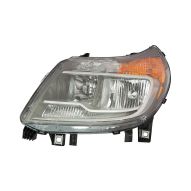Car Headlights and Its Three Major Types

When traveling down that particular dingy road, the headlights are among the most critical aspects of the automobile. To put it another way, having properly operating headlights is essential to your road safety. A faulty headlight should be replaced as soon as feasible to maintain your vehicle legal and safe.
It illuminates the road ahead of you, notifies approaching vehicles like Nissan Altima 2008 Headlight blinks in your presence, and much more. Carbide lamps, which were employed in the beginnings of automobiles, have given way to laser lights in the present day. Headlights come in various shapes and sizes, and manufacturers utilize a variety of them. Today, we’ll go over some of the most often used types:-
Halogen, LED, Xenon/HID, and Laser are the four most prevalent types of car headlight bulbs. If you’ve ever wondered what sort of headlight bulb you’ll need, here’s a fast and straightforward method to help you figure it out:
Halogen
Halogen lights include a single filament or a set of filaments that give either bright or dim headlight functionality. However, the bulb is filled with pressurized gas instead of a vacuum. The lightbulb filaments are made of tungsten.
The glass enclosure is pressured with an inert atmosphere and a tiny quantity of a reactive chemical halogen gas, such as iodine or bromine, to allow halogen lamps to light brightly and faster without darkening anything inside the bulb. A blue coating is applied to some halogen lights to make them look bright than they are.
• Pros
Halogen lights are inexpensive to produce and replace, generally costing just under $20 per bulb, but you must select a reputable brand because some types might burn out in as little as a month. On most automobiles, these can be changed. Some cars may require pieces from the exhaust pipe or the splash shield to be removed.
LED
Light-Emitting Diode headlamp bulbs are illuminated by a fancy phrase called electroluminescence, which means that electrons are shot into charged particles’ holes in a semiconductor, releasing energy in photons which are light particles.
Dashboard lighting and screen consoles are now equipped with the same technology. LED lights are also being utilized in a rising variety of vehicle stop lamps, tinted headlights, interior lamps, residential illumination, and indication lights on appliances and powerful torches. To put it another way, LED lights are utilized almost everywhere these days.
• Pros
LED bulbs are made up of miniature semiconductors that may be organized in various ways to fit into small places. This permits manufacturers to create more streamlined headlamp designs and more incredible style options for other installation components, like turn signal lights.
Finally, these are energy-efficient, and they can be rapidly turned on and off.
Xenon/HID
Xenon, often known as HID lights or High-Intensity Discharge lights, is a kind of headlamp seen on higher-end cars. These headlights use a mixture of xenon and argon gases and liquefied metals to produce a very brilliant light. With conversion kits from several aftermarket vendors, switching to Xenon/HID headlights is possible.
• Pros
HID headlights produce light with a bluish-white color (4,000-6,000 Kelvin), which gives a broader (further) spectrum of illumination.
Laser
Laser headlights are a relatively new development in vehicle lighting technology. Chemiluminescence, or light production by activating a chemical reaction, is used to illuminate these lights.
The phosphorous gas within the container glows when laser beams pass through it. The light emanating from the gas, not the light beams themselves, is visible next to your car. To put it another way, the lasers in the headlight component shine on mirrors, which bounce onto a lens packed with a specific gas to generate a powerful light beam.
• Pros
LED bulbs are less efficient than laser headlights. They can create 1,000 times the quantity of light while using half the energy that LEDs do. They’re also generally much smaller than the latter, allowing for a shallower assembly design.
They offer a wide range of adaptable applications and are simple to turn on and off.
These are the most common types of headlights used by manufacturers. As with any other technology, the technology will advance with time, and it will be able to trickle down to cars like Nissan Altima 2008 Headlight.

Leave a Reply